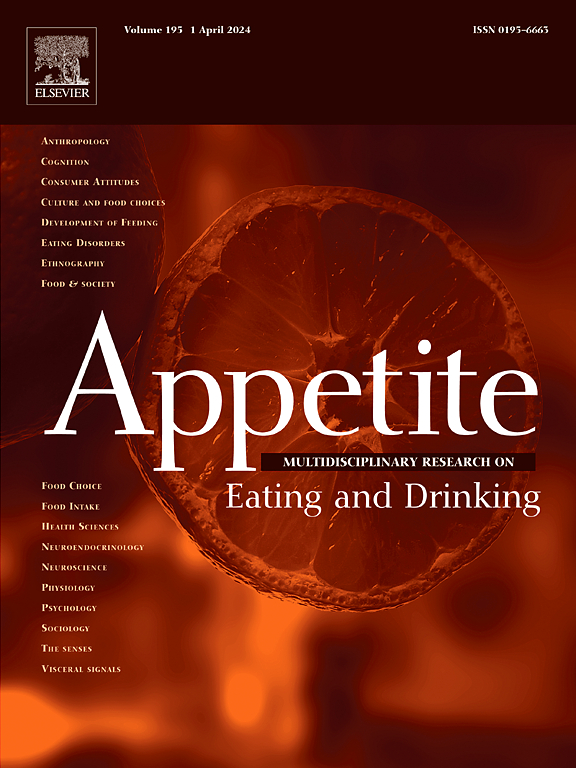揭示内感受加工和行动动力学:利用功能磁共振成像探索对食物线索的神经和心理反应
IF 3.8
2区 医学
Q1 BEHAVIORAL SCIENCES
引用次数: 0
摘要
对身体信号的感知对维持代谢稳态至关重要,被认为在肥胖中起着至关重要的作用。尽管概念性假设岛内感受功能主要通过调节运动皮质导致肥胖风险,但这种联系尚未得到广泛探讨。因此,为了进一步研究食物线索加工的神经和心理成分,特别是基于胰岛素的内感受性加工,本研究通过功能磁共振断层扫描(fMRI)评估了45名健康参与者(31名女性/14名男性,年龄35.78±10岁,BMI 29.52±3.5 kg/m2)在块设计食物线索反应任务中的血氧水平依赖(BOLD)反应。感兴趣区(脑岛)和全脑体素相关分析探讨了食欲感觉的神经相关性。在心理层面上,食欲感觉(P <;0.01, d = 0.68)显著增加,而渴望控制(P = 0.04, d = 0.37)减少。体素相关分析确定了正相关(P <;主观食欲感觉与中央前回(PrG或运动皮层)、脑岛、额下回(IFG)、后扣带皮层(PCC)和顶叶上小叶(SPL)的激活之间的差异为0.01)。此外,在食物提示暴露期间,在岛- prg - ifg网络中发现了功能连接动态的改变,IFG-PrG连接显著减少(P = 0.05)。有趣的是,GFA揭示了跨神经和心理/行为测量的跨单位潜在因素。总的来说,我们的研究结果表明,随着运动皮层活动的增加,脑岛的内感受性加工,以及对IFG抑制控制的减弱,有助于食欲状态的增强,并可能导致体重增加。进一步的研究纳入圆满阶段可能提供更深层次的神经机制的产生行为倾向的食物消费模式的见解。本文章由计算机程序翻译,如有差异,请以英文原文为准。
Unraveling interoceptive processing and action dynamics: Exploring neural and psychological responses to food cues using fMRI
Interoception, the perception of body signals, which is crucial for maintaining metabolic homeostasis, is asserted to play a vital role in obesity. Despite conceptual assumptions that insular interoceptive functioning contributes to obesity risk, predominantly through modulating motor cortices, this link has not been extensively explored. Therefore, to further investigate neural and psychological components underlying the processing of food cues with a specific focus on insula-based interoceptive processing, this study assessed blood oxygenation level-dependent (BOLD) responses via functional magnetic resonance tomography (fMRI) in 45 healthy participants (31 females/14 males, age 35.78 ± 10 years, BMI 29.52 ± 3.5 kg/m2) during a block-designed food cue reactivity task. Region of interest (insula) and whole brain voxel-wise correlation analyses explored neural correlates of appetitive sensations. At the psychological level, appetitive sensations (P < 0.01, d = 0.68) significantly increased, while craving control (P = 0.04, d = 0.37) decreased after cue exposure. Voxel-wise correlation analysis identified positive correlations (P < 0.01) between subjective appetitive sensation and activation of the precentral gyrus (PrG or motor cortex), insula, inferior frontal gyrus (IFG), posterior cingulate cortex (PCC), and superior parietal lobule (SPL). Moreover, altered functional connectivity dynamics were noted within the insula-PrG-IFG network during food cue exposure, with a significant reduction of IFG-PrG connections (P = 0.05). Interestingly, GFA unveiled a cross-unit latent factor across neural and psychological/behavioral measures. Overall, our findings suggest that interoceptive processing in the insula with increased motor cortex activity, and diminished inhibitory control of IFG contribute to the enhancement of an appetitive state and possibly subsequent weight gain. Further research incorporating the consummatory phase may offer deeper insights into the neural mechanisms underlying the generation of action tendencies toward food consumption patterns.
求助全文
通过发布文献求助,成功后即可免费获取论文全文。
去求助
来源期刊

Appetite
医学-行为科学
CiteScore
9.10
自引率
11.10%
发文量
566
审稿时长
13.4 weeks
期刊介绍:
Appetite is an international research journal specializing in cultural, social, psychological, sensory and physiological influences on the selection and intake of foods and drinks. It covers normal and disordered eating and drinking and welcomes studies of both human and non-human animal behaviour toward food. Appetite publishes research reports, reviews and commentaries. Thematic special issues appear regularly. From time to time the journal carries abstracts from professional meetings. Submissions to Appetite are expected to be based primarily on observations directly related to the selection and intake of foods and drinks; papers that are primarily focused on topics such as nutrition or obesity will not be considered unless they specifically make a novel scientific contribution to the understanding of appetite in line with the journal's aims and scope.
 求助内容:
求助内容: 应助结果提醒方式:
应助结果提醒方式:


